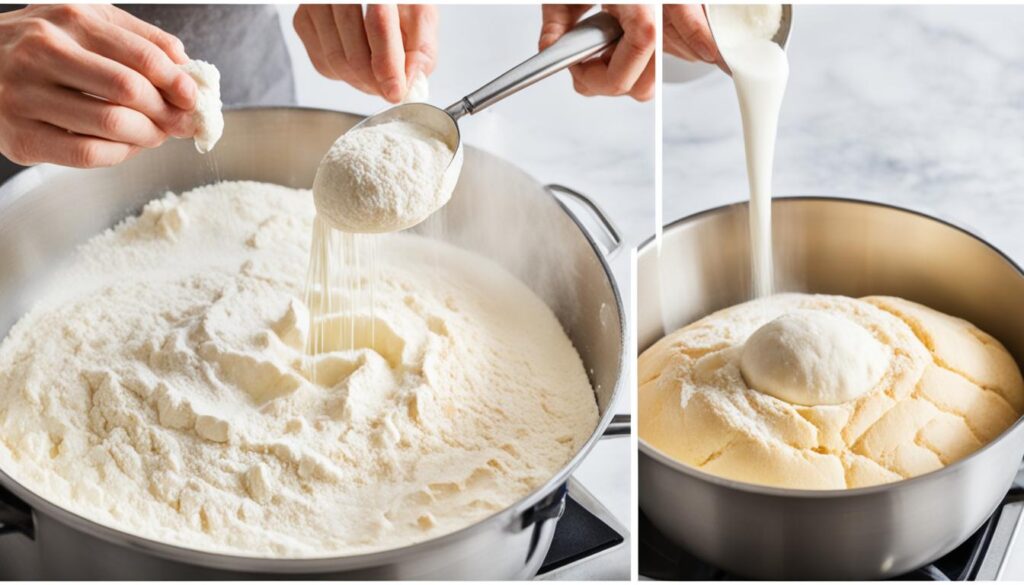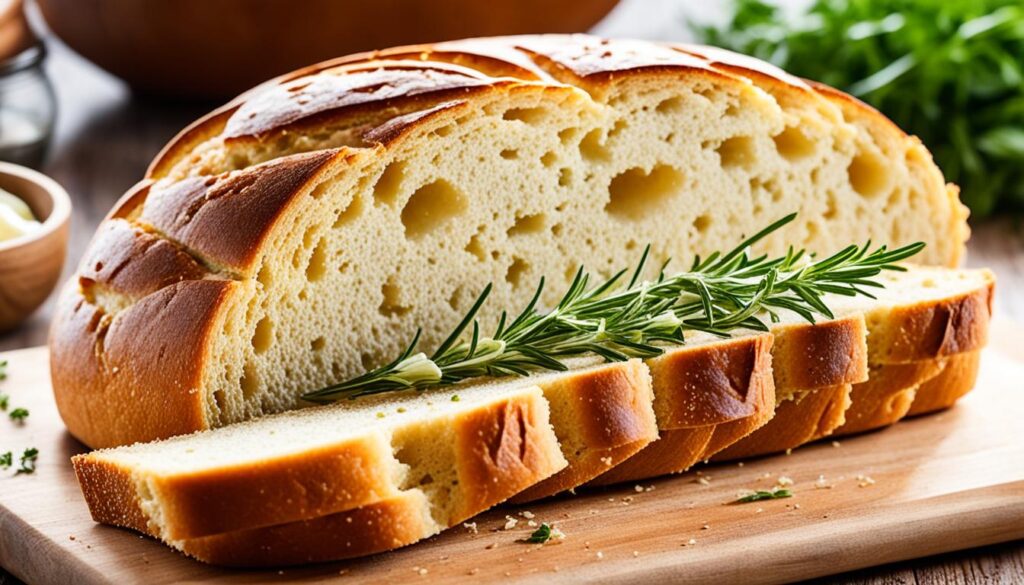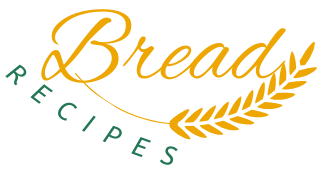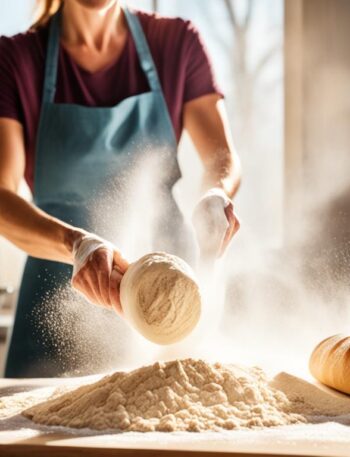Have you ever wondered how to achieve that perfect soft and fluffy texture in homemade bread? Is there a secret technique that professional bakers use? Well, we’re about to let you in on an amazing easy bread making secret – the Tangzhong Method!

The Tangzhong Method is a game-changer when it comes to bread making. It involves creating a simple mixture known as a Tangzhong starter, which is then incorporated into the dough. But what makes this method so remarkable?
In this article, we will take you on a journey to unravel the mysteries of the Tangzhong Method. From its origins and popularity to the step-by-step guide on creating your own Tangzhong starter, we will explore everything you need to know to master this revolutionary bread making technique.
So, are you ready to take your bread baking skills to the next level and amaze your friends and family with the softest and fluffiest bread they’ve ever tasted? Let’s dive into the world of Tangzhong!
Key Takeaways:
- Discover the secret behind the Tangzhong Method for soft and fluffy bread.
- Unveil the origin and popularity of Tangzhong in bread making.
- Learn the step-by-step process of creating a Tangzhong starter.
- Understand the unique qualities that make Tangzhong bread so special.
- Explore the benefits of Tangzhong in keeping bread fresher for longer.
Unveiling the Tangzhong Technique: A Natural Solution for Enhanced Bread Texture
The Tangzhong technique is a revolutionary method that promises to take your bread making to the next level. Not only does it result in a bread with a soft and fluffy texture, but it also offers a natural solution for achieving enhanced bread texture without relying on artificial additives. In this section, we will explore the intricacies of Tangzhong bread making, uncover the origin and popularity of the technique, and contrast it with Western bread improvers.
An Introduction to Tangzhong Bread Making
Tangzhong bread making involves the incorporation of a water-roux mixture called Tangzhong, which is made by cooking a combination of flour and water until it forms a thick and gelatinous paste. This Tangzhong is then added to the bread dough, enriching it with moisture and enhancing its softness. The result is a loaf of bread that is delightfully tender and stays fresh for longer.
Origin and Popularity of Tangzhong
The Tangzhong technique originates from Japan, where it was first introduced in the 1960s by a Chinese cookbook author named Yvonne Chen. Chen discovered that adding a Tangzhong paste to bread dough resulted in a significant improvement in texture and shelf life. This technique quickly gained popularity in Asian countries, known for their love of soft and fluffy bread. Today, Tangzhong bread making has caught the attention of bakers worldwide, who are eager to achieve the same exceptional results in their bread.
Contrasting Tangzhong with Western Bread Improvers
While Western bread improvers rely on chemical additives and enzymes to enhance bread texture and extend shelf life, Tangzhong offers a natural alternative. By using the Tangzhong technique, bakers can achieve remarkable results without the need for artificial enhancers. Tangzhong bread not only retains moisture more effectively but also delivers a more enjoyable eating experience with its soft and tender crumb. This stark contrast makes Tangzhong a preferred choice for those seeking a more natural and wholesome approach to bread making.
With the Tangzhong technique, you can elevate your bread making skills and create loaves that are truly exceptional. Let’s delve deeper into the Tangzhong method and uncover the secrets to achieving the perfect loaf of bread.
What Is The Tangzhong Method
In the world of bread making, the Tangzhong Method is a game-changer. But what exactly is it? Well, let’s uncover the fascinating details of this revolutionary technique that’s taking the baking world by storm.
The Tangzhong Method is a unique approach to bread making that involves creating a starter called Tangzhong. This starter is made by cooking a mixture of flour and water until it forms a thick, paste-like consistency. The Tangzhong starter is then incorporated into the bread dough, resulting in bread that is incredibly soft, moist, and has an unmatched lightness.

The secret behind the Tangzhong Method lies in its ability to capture and retain moisture, resulting in bread that stays fresh for longer periods. The gelatinized starch in the Tangzhong starter helps to retain water, creating a bread that is moist and tender.
But that’s not all. The Tangzhong Method also enhances the texture of the bread, giving it a soft and fluffy crumb. The gelatinized starch in the Tangzhong starter traps air bubbles during the baking process, resulting in a light and airy texture that is a delight to bite into.
So, whether you’re a seasoned baker or a novice in the kitchen, the Tangzhong Method is a technique that can elevate your bread-making game. With its simple yet effective principles, you’ll be well on your way to creating bakery-worthy bread that will impress even the most discerning taste buds.
Step-by-Step Guide: Creating Your First Tangzhong Starter
Now that you have a good understanding of what the Tangzhong Method is and how it enhances bread texture, it’s time to roll up your sleeves and create your very own Tangzhong starter. This step-by-step guide will walk you through the process, from the ratio of flour to water to cooking the Tangzhong to perfection, and finally, cooling and storing it for future use.
Ratio of Flour to Water for the Perfect Tangzhong
The first step in creating your Tangzhong starter is to determine the right ratio of flour to water. This is crucial for achieving the desired consistency and texture. The recommended ratio is 1 part flour to 5 parts water. For example, if you use 100 grams of flour, you will need 500 grams of water.
Cooking the Tangzhong to Perfection
Once you have the flour and water measured, it’s time to cook the Tangzhong. In a saucepan, combine the flour and water, and whisk until there are no lumps. Place the saucepan over medium heat and continue to whisk the mixture constantly. Cook until the mixture thickens and reaches a temperature of 149°F (65°C). This process should take about 2-3 minutes. The consistency of the Tangzhong should be similar to a thick pudding.
Cooling and Storing Your Tangzhong
After cooking the Tangzhong, remove it from the heat and let it cool completely. Transfer the Tangzhong to an airtight container and store it in the refrigerator for up to 3 days. This will allow the Tangzhong to develop its full potential, enhancing the texture of your bread.
Now that you have successfully created your Tangzhong starter, you are one step closer to enjoying soft and fluffy bread made with this amazing technique. In the next section, we will explore the secrets to achieving that perfect texture and learn about different variations of Tangzhong recipes.
The Secret to Soft and Fluffy Tangzhong Bread
Are you ready to unlock the secrets to achieving the softest, fluffiest Tangzhong bread? Look no further! In this section, we will reveal the insider tips and tricks that will take your Tangzhong bread to the next level.
Tangzhong bread is known for its irresistibly tender texture, and the key lies in the unique qualities of the Tangzhong method. The secret lies in the magic of the tangzhong starter, which creates a gel-like mixture that adds moisture and enhances the dough’s structure.

One of the secrets to achieving the perfect texture is to ensure your Tangzhong starter is cooked to perfection. The tangzhong should be heated until it reaches the ideal consistency, which is when it thickens and forms lines as you stir.
“The key to soft and fluffy Tangzhong bread lies in the magic of the tangzhong starter.”
Another secret is the careful handling of the dough. When kneading the Tangzhong bread dough, be gentle and avoid overworking it. This will help maintain the airiness of the bread, resulting in a lighter, more delicate texture.
And let’s not forget about the proofing process! Giving the dough enough time to rise and develop its flavors is crucial for achieving soft and fluffy Tangzhong bread. Make sure to find a warm, draft-free spot for proofing, allowing the dough to rise to its full potential.
By following these secrets to tangzhong bread texture, you’ll be able to create bakery-worthy loaves that are soft, fluffy, and oh-so-delicious. Get ready to impress your family and friends with your newfound bread-making skills!
Tangzhong Recipe Variations for Every Baker
One of the great things about the Tangzhong Method is its versatility in creating a wide range of bread variations. With just a few adjustments to the Tangzhong recipe, you can customize your bread to suit your taste preferences and baking goals. Whether you prefer a hearty whole wheat loaf or a delicate brioche, the Tangzhong Method can be adapted to accommodate different types of bread.
Adjusting the Tangzhong Recipe for Different Types of Bread
When experimenting with different bread recipes, you may need to tweak the ratios of flour to water in the Tangzhong to achieve the desired texture and consistency. For denser breads like whole wheat or rye, you might want to increase the amount of Tangzhong in the recipe to improve the softness and moisture retention. On the other hand, for lighter breads like French baguettes or ciabatta, you may opt for a smaller amount of Tangzhong to maintain a more airy and crusty texture.
It’s important to note that adjusting the Tangzhong recipe requires some experimentation and practice. Start by making small adjustments and keeping track of the results. Over time, you’ll develop a better understanding of how to fine-tune the Tangzhong recipe to suit different types of bread.
Incorporating Tangzhong into Sweet and Savory Recipes
The Tangzhong Method isn’t limited to bread alone. You can also incorporate Tangzhong into sweet and savory recipes for an extra touch of tenderness and moisture. Whether you’re baking a cake, muffins, or even pizza dough, adding a small amount of Tangzhong can take your creations to the next level.
For sweet recipes, such as cakes and pastries, incorporating Tangzhong can result in a softer and moister texture. It helps the baked goods retain moisture, ensuring a delightful, melt-in-your-mouth experience. Similarly, when using Tangzhong in savory recipes like pizza dough or dinner rolls, you’ll achieve a pillowy softness that pairs perfectly with your favorite toppings and fillings.
Incorporating Tangzhong into non-bread recipes may require some experimentation, as the amounts and ratios may differ from traditional bread recipes. It’s best to start with small increments and adjust accordingly based on the desired outcome.
| Bread Variation | Tangzhong Ratio | Result |
|---|---|---|
| Whole Wheat Bread | 20% Tangzhong to flour weight | A softer, more tender crumb |
| Brioche | 10-15% Tangzhong to total liquid | Rich and buttery with a delicate texture |
| French Baguette | 5-8% Tangzhong to total dough weight | Airier crumb with a crisp crust |
| Pizza Dough | 10-15% Tangzhong to flour weight | Soft and chewy crust |
Kneading and Proofing: Mastering the Art of Bread Making with Tangzhong
In this section, we will explore the essential techniques for kneading and proofing dough when using the Tangzhong method. These techniques are crucial for achieving superior texture and flavor in your Tangzhong bread.
Kneading Techniques for a Superior Dough Texture
The key to creating a superior dough texture lies in the kneading process. Kneading helps develop the gluten in the dough, resulting in a light and airy texture. When kneading with Tangzhong, consider the following techniques:
- Spiral Kneading: This technique involves using the heel of your hand to gently push the dough away from you, then folding it back towards you in a circular motion. Repeat this process, gradually incorporating the Tangzhong starter, until the dough becomes smooth and elastic.
- Stretch and Fold: For this technique, gently stretch the dough out and fold it over itself. Rotate the dough and repeat the stretching and folding process. This method helps to develop the gluten and create a strong dough structure.
- Windowpane Test: To ensure your dough is properly kneaded, perform the windowpane test. Take a small piece of dough and stretch it gently. If the dough stretches without tearing and forms a thin, translucent membrane, it’s ready for proofing.
By employing these kneading techniques, you’ll achieve a superior dough texture that will result in irresistible Tangzhong bread.
Understanding the Proofing Process in Tangzhong Bread Making
Proofing is the final rise of the dough before baking. This step is crucial for allowing the flavors to develop and the dough to rise properly. When proofing with Tangzhong, keep the following process in mind:
- First Proof: After kneading, shape the dough into a ball and place it in a greased bowl. Cover the bowl with a clean kitchen towel or plastic wrap and let it rise in a warm, draft-free area for about 1-2 hours, or until the dough has doubled in size.
- Punch Down and Shape: Once the dough has doubled in size, gently deflate it by pressing down with your fingertips, releasing any trapped air. Shape the dough into the desired loaf or roll shapes.
- Second Proof: Place the shaped dough onto a baking sheet or into a greased loaf pan. Cover it again and let it rise for about 30-60 minutes, or until it has doubled in size once more.
- Bake: Preheat your oven to the recommended temperature and bake your Tangzhong bread according to the recipe instructions. Enjoy the aroma that fills your kitchen as your bread bakes to golden perfection!
Understanding and mastering the proofing process is essential for achieving light and fluffy Tangzhong bread with a delicious taste and texture.
Exploring the Benefits: Why Tangzhong Bread Stays Fresher Longer
One of the remarkable benefits of Tangzhong bread is its exceptional moisture retention. The Tangzhong method, with its unique cooking technique and ingredient combination, creates a bread that stays fresh and moist for longer periods compared to traditional breads.
Understanding the Science Behind Tangzhong’s Moisture Retention
The secret of Tangzhong bread’s long-lasting freshness lies in the science behind its moisture retention properties. The Tangzhong starter, made by cooking a portion of the bread’s flour and water mixture, undergoes a process called gelatinization. This process improves the bread’s ability to retain moisture by trapping it within the cooked starch molecules.
The gelatinized starch in Tangzhong bread acts like a sponge, holding onto moisture and preventing it from evaporating during the baking process. As a result, the bread maintains its softness and freshness, even days after baking.
Comparing Shelf Life: Tangzhong vs Traditional Breads
When it comes to shelf life, Tangzhong bread outperforms traditional breads. The superior moisture retention of Tangzhong bread slows down the staling process, making it stay fresh and enjoyable for an extended period. This means you can savor each slice without worrying about the bread becoming dry or hard.
Furthermore, Tangzhong bread’s longer shelf life can help reduce food waste, allowing you to enjoy your homemade bread for a longer time without compromising its quality. It’s a win-win situation for both your taste buds and the environment.
In comparison, traditional breads often lose moisture more quickly, leading to a shorter shelf life. Their lack of moisture retention can result in dry, stale bread after just a day or two.
By choosing Tangzhong bread, you’re not only enjoying a delightful and flavorful loaf but also ensuring that your bread remains fresh for an extended time, maximizing your baking efforts.
Conclusion
As we reach the end of our exploration into the Tangzhong Method, it’s clear that this easy bread making secret holds the key to achieving soft and fluffy bread with enhanced texture. By understanding the principles and techniques behind Tangzhong bread making, you can elevate your baking to a whole new level.
The Tangzhong technique, with its origins deeply rooted in Asian baking traditions, offers a natural solution for creating bread that stays fresher for longer. By using the Tangzhong starter and following the step-by-step guide, you can effortlessly incorporate this technique into your own kitchen.
From adjusting the Tangzhong recipe to suit different types of bread, to mastering the art of kneading and proofing, you now have the knowledge to create a wide variety of tangzhong-based recipes. Whether you’re craving a sweet treat or a savory delight, the possibilities are endless.
So, what are you waiting for? It’s time to embrace the Tangzhong Method and unlock the secrets to soft, fluffy, and irresistibly delicious bread. Get your apron on, gather your ingredients, and start your tangzhong bread making journey today!
FAQ
What is the Tangzhong Method?
The Tangzhong Method is a technique used in bread making to create soft and fluffy bread. It involves creating a Tangzhong starter, which is a mixture of flour and water cooked into a roux-like paste. The Tangzhong starter is then added to the bread dough to enhance its texture.
How does the Tangzhong Method enhance bread texture naturally?
The Tangzhong Method enhances bread texture naturally by increasing moisture retention in the bread. The gelatinized starch in the Tangzhong starter absorbs and holds onto water, resulting in a bread that stays soft, moist, and fluffy for a longer period of time.
How do I make a Tangzhong starter?
To make a Tangzhong starter, combine one part flour with five parts water in a saucepan. Cook the mixture over low heat, stirring constantly, until it thickens and forms a roux-like paste. Allow the Tangzhong starter to cool before using it in your bread recipe.
What are the benefits of Tangzhong bread?
Tangzhong bread has several benefits. It has a longer shelf life compared to traditional breads due to its increased moisture retention. It also has a soft and fluffy texture, making it enjoyable to eat. Additionally, Tangzhong bread stays fresh for longer, making it a great choice for meal prepping or storing for future consumption.
Can I adjust the Tangzhong recipe for different types of bread?
Yes, you can adjust the Tangzhong recipe to suit different types of bread. The ratio of flour to water in the Tangzhong starter can be adjusted depending on the desired texture and consistency of the bread you are making. Experiment with different ratios to achieve the perfect Tangzhong bread for your preferences.
How do I incorporate Tangzhong into sweet and savory recipes?
Tangzhong can be incorporated into both sweet and savory recipes. For sweet recipes, such as cinnamon rolls or chocolate bread, simply add the Tangzhong starter to the dough as instructed in your recipe. For savory recipes, like garlic bread or cheesy rolls, you can add additional herbs or spices to enhance the flavor of the bread.
What are the essential techniques for kneading and proofing dough when using Tangzhong?
When using Tangzhong, it is essential to knead the dough thoroughly to distribute the Tangzhong evenly and activate gluten development. Follow the instructions provided in your recipe for the appropriate kneading time. In terms of proofing, the Tangzhong method may require slightly longer proofing times due to the increased moisture in the dough. Keep an eye on the dough and follow the recommended proofing times.
How does Tangzhong bread compare to traditional breads in terms of shelf life?
Tangzhong bread has a longer shelf life compared to traditional breads. This is because the Tangzhong starter helps retain moisture in the bread, preventing it from drying out quickly. As a result, Tangzhong bread stays fresh for a longer period of time, allowing you to enjoy it days after baking.


